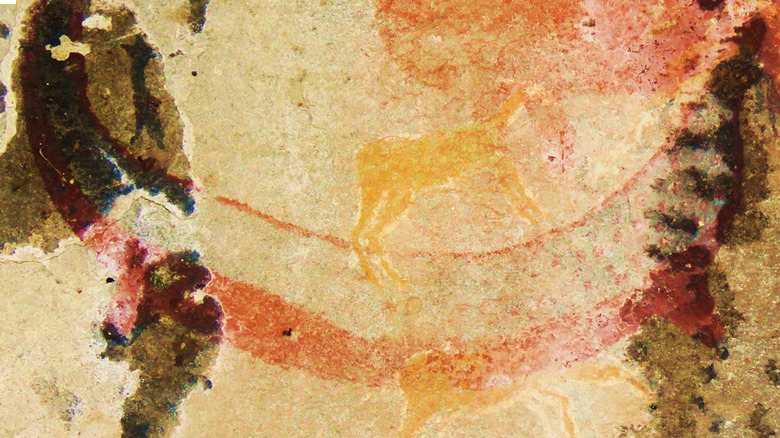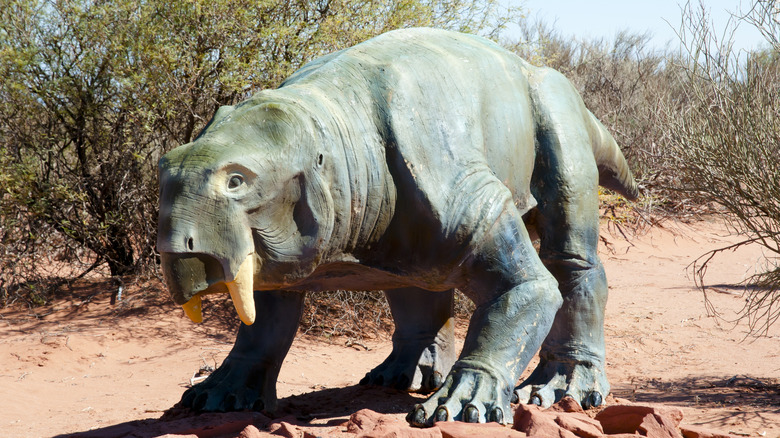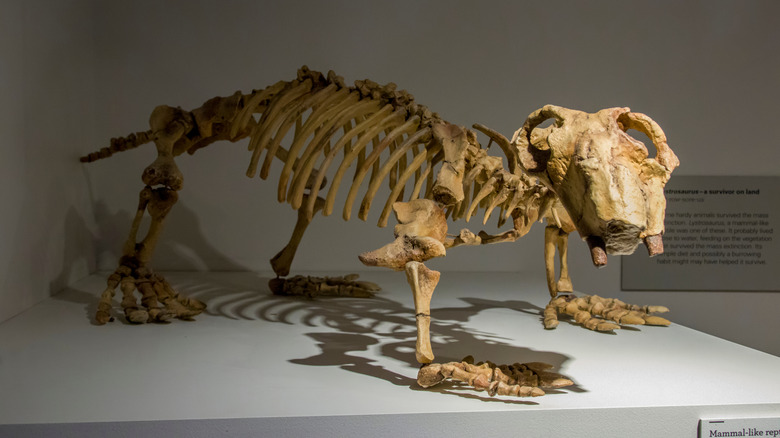Rock Painting Shows Indigenous Africans Beat Paleontologists To A New Discovery
In 1845, British paleontologist Sir Richard Owen announced the discovery of a new species based on fossils uncovered in South Africa. At the time, he had only found remnants of the creature's skull, but that alone was enough to draw considerable attention. It appeared to be reptilian, with a beak much like that of a turtle, but it also had a pair of walrus-like tusks, despite there being no other teeth in the jaw. Owen dubbed his find Dicynodon, from the Latin meaning "two canine teeth," and observed that the significant variations in the size of the fossils indicated that there must have multiple species of dicynodonts.
Few paleontologists in history have a stronger reputation than Richard Owen, being that he was the man who first coined the term "dinosaur," but it appears that he was late to the party on this particular discovery. A work of cave art by the San people of South Africa, estimated to have been painted in the early 19th century, appears to depict a dicynodont at least a decade before Owen discovered the creature, though dicynodonts have been extinct for roughly 200 million years. A new paper published in PLOS One, by Julien Benoit, a paleontologist at South Africa's University of the Witwatersrand, proposes a simple answer to this mystery. While the progress of science has consistently been mapped from a Eurocentric perspective, indigenous peoples have long engaged in their own acts of paleontology, and their arts and cultures could hold even more discoveries about Earth's ancient past.
Dicynodonts were early ancestors of mammals
It is now known that Dicynodon was not a single species, but rather a clade. One of the lesser-known taxonomic terms, cladistics is the practice of sorting species into evolutionary trees. A clade is a group that includes all the descendants of a common ancestor, and it appears that there were over 70 distinct genera within the Dicynodon clade. Fossils vary from the size of small rodents, all the up to Lisowicia bojani, a dicynodont species discovered in Poland that rivals modern elephants in size.
A cursory glance at a dicynodont skull would have you assume it's a type of reptile, given the beak that resembles a turtle or triceratops. However, dicynodonts are more closely related to you than any lizard. They belonged to a group called the therapsids, from which modern mammals originally evolved.
Dicynodonts are even older than the dinosaurs, emerging roughly 270 million years ago in the Permian Period. Remarkably, they managed to survive the End Permian, the worst of Earth's five major mass extinctions. Fossils suggest that dicynodonts lived into the Triassic Period, which was the first time period dinosaurs lived in, meaning dicynodonts and dinosaurs roamed the Earth together for a time before the former died out around 200 million years ago as the dinosaurs cemented their domination over the planet. However, before they were overtaken by the giant reptiles, dicynodonts were the most dominant vertebrates on Earth, and their legacy can be traced through fossils around the world.
How a dicynodont ended up in a cave painting
Dicynodont fossils stand out for their tusks. It is unclear what role they played in the animal's life, considering dicynodonts were herbivorous, but they provide a calling card for paleontologists. When a rock painting depicting an animal with long tusks was found in a cave in the Free State province of South Africa, far from the territory of any walrus, a dicynodont became the prime suspect. The painting even shows dots on the animal's skin reminiscent of the bumpy skin observed in dicynodont fossils.
The art found in the Free State was dated to between 1821 and 1835, ten years before Richard Owen "discovered" Dicynodon. It was painted by members of the indigenous San people. Nomadic hunter-gatherers, the San were the original inhabitants of Southern Africa, but their culture was devastated by European colonialism, under which many San were enslaved. Today, most San live in rural or high poverty areas, and their culture and traditions are threatened.
This painting suggests that the San were recording paleontological discoveries at least 200 years ago, at the same time that Europeans were just beginning to uncover the secrets of fossils. The cave in question is in the Karoo region of South Africa, which is a hotspot for dicynodont fossils. It appears that the San were uncovering specimens well before Europeans began excavating the area. Perhaps most telling of all, the dicynodont painting shows the animal in a very specific position: the same outstretched death pose found in fossils worldwide.


